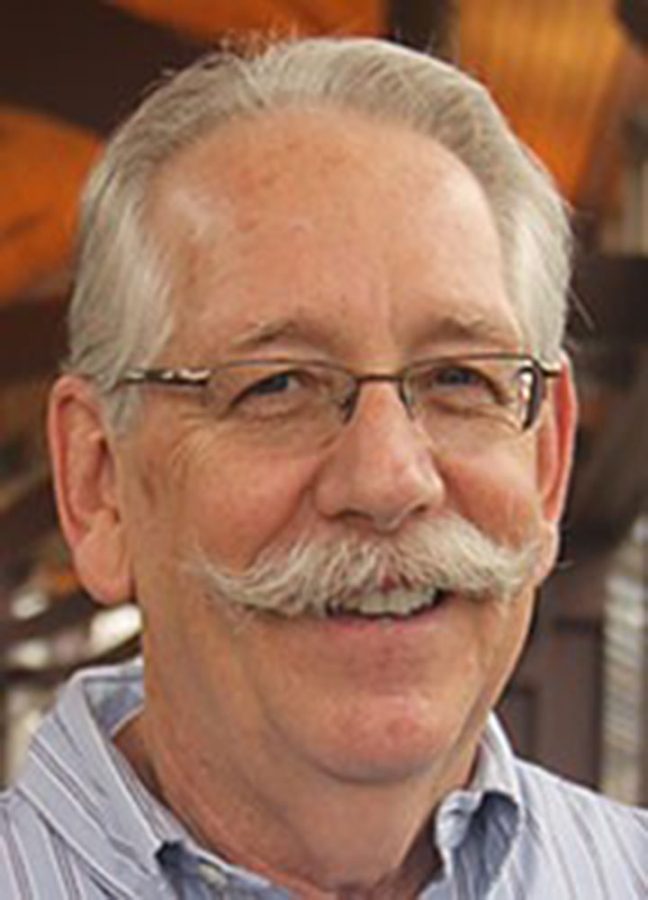Wayne Anderson started out as engineering major
Retiring art professor took satisfaction in ‘moment of awe’ from students
April 28, 2016
“Art isn’t everything, it’s just about everything,” poet Gertrude Stein once said.
Throughout his career at Wayne State College, Wayne M. Anderson professor in the school of Arts and Humanities, has made Stein’s words come to life. He has proven that art is an outlet for growth, and that it can be about anything, much like life in general.
As the school year approaches an end, his retirement approaches its beginning.
Sioux Falls, S.D., is where Anderson calls home.
He graduated from Washington High in 1965. After graduating, Anderson pursued a career in chemical engineering at the South Dakota School of Mines and Technology.
“I attended for one year and had every intention to return but realized that my ultimate goal didn’t include making a machine to inject grape jelly into a jar of peanut butter-an accomplishment of a recent graduate,” he recalled.
He went on to spend some time in southern California. Because he was no longer a student, he was drafted for the Vietnam War, but as he recalls, he “narrowly escaped being sent to Vietnam with the rest of my fellow draftees and was instead rather extensively trained as an electronics technician.”
Only a few years later, his cohort was sent to South Korea.
“I still feel very fortunate as the North Vietnamese Tet offensive began only a short time later,” Anderson said.
A few years later, after readjusting to life in South Dakota, he enrolled at USD to study cinematography, art and literature.
During his time in school, he married his high school sweetheart, Linda. Together they had their daughter, Lori, during his years at USD.
As his years of study progressed, so did his interest in the discipline of printmaking. He graduated with a bachelors of fine arts in 1974. Then he went on to pursue his passion of printmaking by studying with five different printmakers during an assistantship at Southern Illinois University at Edwardsville.
“They were highly qualified but widely divergent in areas of technical expertise and aesthetic orientation. The experience broadened my outlook and capabilities,” Anderson said.
His work experiences have also been broad through the years. Before teaching at WSC, Anderson developed quite the resume.
“While my academic background didn’t follow the standard direct line, my informal education was developed by various occupations.
I have been, among other things, a photographer/curator, a night watchman, a construction laborer, an assembly line worker, a radio tester/tuner, a soldier, a field-radio repairman, a repair shop administrator, an electronic equipment installer for Western Electric, a railroad gandy dancer, a brick layer’s tender, a postal worker, a truck loader, a cook and a dishwasher,” Anderson said.
“I think having had a life outside of academe has not only been a valuable experience, it has made me appreciate being involved in higher education.”
His appreciation for higher education has stuck with him. He began teaching at WSC in 1979. Only 16 positions were nationally available for his degree when he graduated in 1974.
“I was very fortunate a position calling for a printmaker/generalist became available at WSC the following year,” Anderson said.
He admitted that Wayne was much smaller than he would’ve pictured himself ending up at, but he stuck with it because of the personal relationships he developed, and he’s proud of his school.
“Wayne was a much smaller institution than I had envisioned teaching at, with a service-oriented art department that was not an independent entity and print program that was almost nonexistent. The intimacy of the college and the community proved appealing after a time and I found the students to be straight forward, honest and generally very nice people,” Anderson said.
“I am proud to have spent my career here and while I have very much enjoyed participating in the sometimes-hard-fought development of our department in size and stature, nothing has given me more satisfaction than interacting with students as individuals and watching their transformation as artists and people. I value the personal relationships that have been established with both colleagues and students over many years.”
During his time here, Anderson has taught many areas of art. He was hired to teach printmaking and art history, which he did for 36 years. He also taught drawing, studio classes in painting, the American and World Culture honor classes and general education art classes. His passion for art is clear, but his passion for his students is crystal.
“I once had a student who told me at the end of the term that she had decided to suspend her ego at the beginning, determined simply to listen and try to attempt everything with an open and willing mind,” Anderson said.
“Her growth was amazing. I take satisfaction when I see that light go on in someone’s eyes and there’s almost a moment of awe when everything seems to come together. I have really enjoyed helping students develop their ideas both aesthetically and intellectually.”
As if he didn’t have a busy enough schedule full of classes to teach, Anderson continued being involved on campus by serving as the director of the Neihardt Gallery for 34 years and as department chair. He currently serves as Director of the Nordstrand Visual Arts Gallery at WSC and gives public lectures on a wide range of art subjects.
He’s also been involved in many committees across campus including Faculty Senate, Rank, and Academic Policies committees.
As far as future plans goes he plans to still be in touch with his first love art.
“I plan to continue working as an artist, both as a printmaker and object maker. I enjoy my wood shop and working with both power and hand tools and the practice lost arts. I will take pleasure in my wife Linda’s spectacular garden and perhaps travel if the cats will allow it,” Anderson said.







